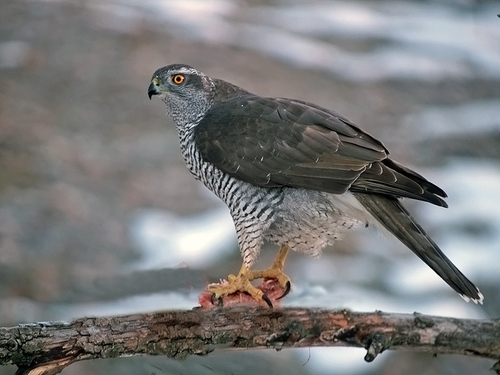
Northern Goshawk
The Northern Goshawk (Accipiter gentilis) is a powerful and secretive bird of prey found in temperate forests across the Northern Hemisphere. Renowned for its fierce hunting prowess and striking appearance, it plays a vital role as a top predator in its ecosystem. While not globally threatened, its populations are sensitive to habitat loss and human disturbance. Culturally, the goshawk has been prized in falconry for centuries, symbolizing strength and skill.
46-63 cm
Length
89-122 cm
Wingspan
Least Concern
Conservation Status
Distribution
Found across North America, Europe, and Asia, primarily in temperate and boreal regions. Migratory patterns vary; some populations are resident, while others undertake short- to medium-distance migrations.
Lifespan
Up to 19 years in the wild, potentially longer in captivity.
Northern Goshawk's Habitat
Habitat Types
Mature forests, Mixed woodlands, Taiga, Mountain forests
Climate Zones
Temperate, Boreal, Subarctic
Adaptations
Prefers large tracts of forest with dense canopy cover for nesting and hunting. Their broad wings and long tail provide maneuverability in dense vegetation.
Variations
Several subspecies are recognized, differing slightly in size and plumage coloration. For example, *Accipiter gentilis atricapillus* is found in North America, while *Accipiter gentilis gentilis* is the nominate subspecies found in Europe.
Appearance
Breeding Plumage
Adult plumage is relatively consistent year-round.
Seasonal Feather Changes
Minimal seasonal variation.
Sex Based Plumage Differences
Adult males have a slate-gray back and finely barred underparts, while females tend to be browner. Both sexes have a distinctive white eyebrow stripe.
Notable Features
Prominent white eyebrow stripe, Dark cap, Red or orange eyes in adults, Powerful talons
Diet and Feeding
Primary Foods
Birds (e.g., grouse, pigeons, songbirds), Small mammals (e.g., squirrels, rabbits, hares)
Foraging Behavior
A skilled and agile hunter, the Northern Goshawk uses a combination of stealth and speed. It often perches and waits for prey, then attacks with a rapid burst of flight. It can also pursue prey through dense forest.
Specializations
Strong talons and beak adapted for capturing and consuming a variety of prey.
Seasonal Diet Variations
Diet may shift slightly depending on prey availability. For instance, they may take more mammals in winter when some bird species have migrated.
Behavior
Social Structure
Generally solitary or found in pairs, except during migration when small groups may form.
Communication
A variety of calls, including a loud 'kek-kek-kek' alarm call, Whistles and wails during courtship
Migration
Some populations are resident, while others undertake partial migrations, often following prey movements. Northern populations tend to migrate further south.
Territorial or Group Behaviors
Highly territorial during the breeding season, defending their nesting area aggressively against intruders, including other goshawks and humans.
Conservation
Threats
Habitat loss and fragmentation (due to logging and development), Prey depletion, Historically, persecution by humans
Protection Programs
Forest management practices that maintain suitable habitat, Monitoring programs
Local National Laws
Protected under various national and international laws, such as the Migratory Bird Treaty Act in the United States.
Population Trend
Stable
Population Estimates
Difficult to estimate precisely due to their secretive nature, but the global population is considered relatively large.
Interesting Facts
They are known for their aggressive defense of their nests.
Goshawks will attack humans who approach too closely to their nest.
They have been used in falconry for centuries.
Their speed and agility make them prized hunting birds.
Juveniles have different plumage than adults.
Young goshawks have brown upperparts and streaked underparts, gradually acquiring adult plumage over several years.
Faqs about Northern Goshawk
What is the biggest threat to Northern Goshawks?
Habitat loss and fragmentation due to logging and development are major threats.
Are Northern Goshawks dangerous to humans?
They can be aggressive when defending their nests, but attacks on humans are rare. It's best to keep a safe distance from nesting areas.
How can I tell a Northern Goshawk from other hawks?
Look for the distinctive white eyebrow stripe, dark cap, and relatively large size. Their flight is characterized by quick wingbeats and glides.
Copyright @ Nature Style Limited. All Rights Reserved.
 English
English